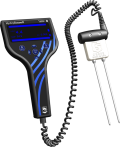This product is no longer available.

| Services Available | |
|---|---|
| Repair | Yes |
| 校准 | 不 |
| 免费支持 | Yes |
Overview
CS625测量从0%到饱和度的体积水含量。它类似于我们的CS616,但专为CR200(X)和CR300系列数据转主而设计。该反射仪具有0至3.3 V方波频率输出,我们的CR300系列和CR200(x)-series Dataloggers可以测量。
Read More福利和特色
- High accuracy and high precision
- Fast response time
- 专为长期无人参与水含量监测而设计
- 探针杆可以从表面插入或掩埋到表面的任何方向。
Images

详细说明
CS625由连接到印刷电路板的两个30厘米长的不锈钢棒组成。电路板封装在环氧树脂中,屏蔽的四导电缆连接到电路板以供电,使能探头,并监控输出。
CS625使用时域测量方法测量多孔介质(如土)的体积含水量;不需要反射仪(电缆测试仪),例如TDR100。该方法包括CS625产生电磁脉冲。然后测量经过的行程和脉冲反射并用于计算土壤体积含水量。
响应特征
沿CS625的平行杆传播的信号通过土壤溶液和土壤矿物馏分的导电成分中的自由离子衰减。在大多数应用中,衰减不足以影响对改变含水量的CS625响应,并且通过标准校准很好地描述了响应。然而,在具有相对高的土壤导电水平,压实土壤或具有高粘土含量的土壤中的土壤中,应为特定培养基调整校准。操作手册中提供了进行这些调整的指导。
Specifications
| Measurements Made | 多孔介质的体积含水量(如土壤) |
| Water Content Accuracy | ±2.5% VWC (using standard calibration with bulk EC of ≤ 0.5 dS m-1, bulk density of ≤ 1.55 g cm-3, and measurement range of 0% to 50% VWC) |
| 需要设备 | Measurement system |
| 土壤适宜性 | Long rods and lower frequency are well-suited for soft soil with low electrical conductivity (< 2 dS/m). |
| 棒子 | 不可替换 |
| Sensors | 不t interchangeable |
| Operating Temperature Range | 0°至70°C |
| 探针探测变异性 | 干土中±0.5%VWC,典型饱和土壤中的±1.5%VWC |
| 精确 | 0.1% VWC |
| 解决 | 0.1% VWC |
| Output | 0至3.3 V方波(频率依赖于含水量) |
| 当前的流失 |
|
| Power Supply Voltage | 5 Vdc minimum; 18 Vdc maximum |
| Enable Voltage | 4 VDC最小值;18 VDC最大值 |
| Electromagnetic | CE compliant (Meets EN61326 requirements for protection against electrostatic discharge.) |
| 杆间距 | 32毫米(1.3英寸) |
| Rod Diameter | 3.2 mm (0.13 in.) |
| Rod Length | 300毫米(11.8英寸) |
| Probe Head Dimensions | 85 x 63 x 18 mm (3.3 x 2.5 x 0.7 in.) |
| Cable Weight | 每米35克(每英尺0.38盎司) |
| Weight | 280克(9.9盎司)没有电缆 |
Compatibility
不te:以下显示了显着的兼容性信息。它不是所有兼容或不兼容产品的全面列表。
Data Loggers
| Product | Compatible | 不te |
|---|---|---|
| CR1000.(retired) | ||
| CR200x.(retired) | ||
| CR206X(retired) | ||
| CR211x.(retired) | ||
| CR216X(retired) | ||
| CR295X(retired) | ||
| CR300. | ||
| CR300.0(retired) | ||
| CR310 | ||
| CR5000(retired) | ||
| CR800 | ||
| CR850. | ||
| CR9000x.(retired) |
额外的兼容性信息
RF考虑因素
如果CS625能够小于0.6ms,则RF排放量低于FCC和EUS61326中规定的欧盟限制,并且比每秒减少频繁的测量。外部RF源也会影响CS625操作。因此,CS625应远离RF的重要来源,例如AC电力线和电机。
Installation Tool
The CS650G makes inserting soil-water sensors easier in dense or rocky soils. This tool can be hammered into the soil with force that might damage the sensor if the CS650G were not used. It makes pilot holes into which the rods of the sensors can then be inserted. It replaces both the 14383 and 14384.
数据记录器考虑因素
Each CS625 requires a single-ended input channel. A control port is used to enable one or more probes.
不te: A maximum of four CS625 probes can be measured by one CR200(X) datalogger. Valid channel options are analog channels 1 through 4.
文件
Brochures
Compliance
常见问题
Number of FAQs related toCS625:34
展开全部全部收缩
-
300 m (1,000 ft).
-
Yes, as long as the data logger can detect a 0 to 3300 mV square wave over a frequency range of 29 to 67 kHz.
-
不可以。输出太快,无法在21倍或CR7的脉冲通道上测量。
-
If the electrical conductivity within the waste is less than 5 dS/m and there is good contact between the probe rods and the waste, the CS616/CS625 should respond predictably to changes in water content. The heterogeneous nature and changing bulk density of solid waste, however, make calibration difficult.
-
If a soil-specific calibration is performed, the CS616/CS625 may be used in soil with a maximum bulk electrical conductivity of 5 dS/m.
-
Yes. The rugged design of the CS616/CS625 protects the probe electronics from water under these conditions. Many CS616/CS625 reflectometers have been working reliably in very wet conditions for more than ten years.
-
Some customers have tried to use the CS616 or CS625 to measure the moisture content within a tree, but the calibration proved to be problematic. Campbell Scientific cannot provide any specific guidance for this application.
-
细根不会显着影响CS616 / CS625阅读。
-
Yes. For program examples and guidance on using a multiplexer with one of these reflectometers, see theCS616 and CS625 instruction manual.
-
Cutting down rods should only be done at the user’s own risk. Doing so will cause the probe to need recalibration. Campbell Scientific does not provide calibrations for shorter rod lengths for the CS616 or the CS625.
With shorter rods, the probe will work, but there will be some reduction in accuracy because the length of the rod in the soil contributes a smaller proportion to the total transit time. However, probes with shorter rods will work in more saline soils.
隐私政策更新
We've updated our privacy policy.Learn More



